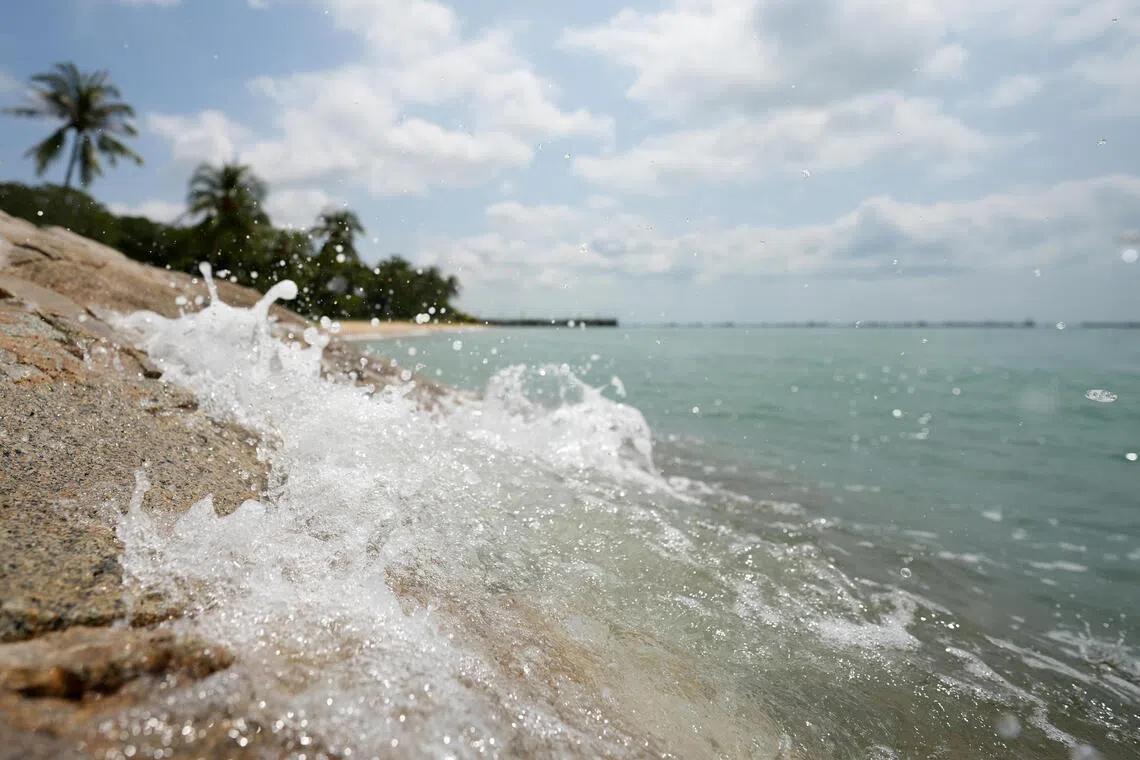S’pore Water Association launching new course to grow experts to tackle sea-level rise
Sign up now: Get ST's newsletters delivered to your inbox

Professionals need to understand the coastal environment and its processes, and find ways to provide early warning for extreme coastal events.
PHOTO: LIANHE ZAOBAO
Follow topic:
- Singapore is boosting coastal protection with seawalls and mangroves to combat rising sea levels, necessitating a skilled workforce.
- The Singapore Water Association (SWA) is launching an eight-module course to train professionals in coastal protection, addressing expertise gaps.
- Singapore aims to become a South-east Asian hub for coastal resilience, exporting solutions and expertise, building on its water technology success.
AI generated
SINGAPORE – The Republic’s coastlines are set to be bustling with activity in the next few decades, as seawalls, coastal barriers and mangroves will be used to defend the island from rising seas.
To meet the talent gap in the emerging coastal protection sector, the Singapore Water Association (SWA) is launching a course to increase the number of professionals and help current ones beef up their knowledge on shielding coastlines and managing floods.
The first two modules will run on Oct 2 and 3, and the rest of the six modules will be held every quarter or so, stretching to the second half of 2026. The modules will cover coastal processes, flood modelling, marine biodiversity and ecology, construction and community engagement, among other topics.
The SWA is a 21-year-old organisation that represents Singapore’s water industry. Its coastal protection chapter was formed in 2024.
Initially expecting no more than 25 people to sign up for the masterclass, SWA’s managing director Michael Toh was encouraged to see close to 40 attendees. Most are engineers who may be looking to pivot and specialise in coastal protection, with some civil servants from government agencies.
The masterclass is relevant to those with at least five years of work experience in the engineering field.
Mr Yang Zi Qian, training and education lead of SWA’s coastal protection chapter, said: “This particular field is very specialised, and there is not a lot of expertise in terms of available talent in Singapore. On a global level, coastal protection is still a niche field.”
Recognising that plans for every section of Singapore’s coastline will be unveiled in the coming years, the chapter’s chair, Mr James Lam, said: “The intensity and speed at which things are going to roll out is so huge that more players must jump in.”
Mr Yang, who is also managing director of Delta Marine Consultants Singapore, noted that globally, some countries – such as low-lying Netherlands and tsunami-prone Japan – have advanced knowledge in protecting their coastlines.
He noted that Singapore has a mature civil engineering workforce within South-east Asia, and this stands the country in good stead for some engineers to pivot to coastal defence.
The country is not unfamiliar with building waterfront infrastructure and protecting the coastlines from erosion, with 70 per cent to 80 per cent of the country’s coastline being covered by seawalls and stone embankments.
But understanding the complexities behind sea-level rise and how these will affect coastal properties is a different ball game, added Mr Yang.
By 2100, average sea levels around Singapore could rise by up to 1.15m. Storm surges and tides can add another increase of 3m or 4m and cause coastal flooding if the shores are not protected.
Professionals need to understand the coastal environment and its processes, come up with solutions that avoid harm to marine life, and find ways to provide early warning for extreme coastal events. They also need to navigate future changes in coastal-related policies.
The eight-module course aims to address these components through lectures, discussions and field visits.
Each module will last a whole day, and the first one on Oct 2 will cover coastal processes such as tides, waves and sediment movement that govern how coastlines evolve. The behaviour of each coastline determines the types of defences that will work for it.
Field trips over the $6,000 course could include visits to a biodiversity-rich coastal area and a hydraulics lab that tests how waves affect novel structures.
The course by SWA is not the only one dedicated to coastal protection here. The National University of Singapore offers a graduate certificate in coastal protection and flood management.
Separately, at the end of October, the SWA will take local industry leaders to the Netherlands to find out more about the country’s coastal solutions and forge business links with the more mature Dutch industry. The leaders are expected to visit a famed storm surge barrier, among other engineering solutions pioneered in Holland.
National water agency PUB’s deputy chief executive (flood resilience) Angela Koh said SWA’s masterclass is a key initiative that will address existing knowledge and skill gaps in the industry, ahead of a pipeline of coastal protection works.
“Given Singapore’s unique coastal and urban conditions, it is crucial that we have skilled talent who understand our local context and can offer customised solutions to build a more resilient coastline for Singapore,” Ms Koh told The Straits Times.
Ultimately, SWA envisions the sector in Singapore to eventually serve as a South-east Asian “hub” for coastal resilience, said SWA’s Mr Lam, who is also Surbana Jurong’s executive director for coastal engineering.
“Professionals in the region can come here to gain knowledge and find probable solutions. Singapore-based companies can export their coastal solutions and capabilities out to South-east Asia,” he added.
Since NEWater was unveiled more than 20 years ago, Singapore has earned global recognition as a leader in membrane technology for water recycling and desalination. Likewise, coastal defences can be the next crucial frontier for the local sector, said SWA’s Mr Toh.


